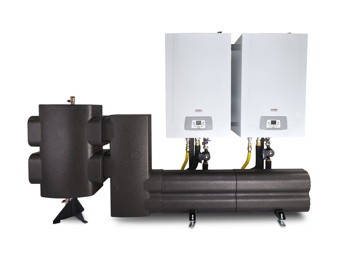Maximising the potential of condensing boilers

Replacing an existing commercial boiler of up to 400 kW with a condensing model will meet the requirements of the Ecodesign of Energy-related Products Directive (ErP), but as Steven Evans, national sales manager at Potterton Commercial, explains, there is more to consider if you want to achieve the most energy-efficient solution.
Since September 2015, under the ErP Directive for space heaters in commercial premises, boilers of up to 400 kW have had to be high-efficiency condensing models.
Condensing boilers are capable of achieving over 90 % thermal efficiency compared with 70 to 80% with non-condensing models. They achieve this by extracting heat from exhaust gases that are dispersed via the flue into the atmosphere. These gases are sent through a heat exchanger, which cools and condenses the water vapour in them back into liquid form or condensate which contains much of the heat that would otherwise lost. Replacing a non-condensing boiler and updating controls can save up to 25% of energy costs, depending on consumption.*
To achieve maximum efficiency and long-term cost savings, however, boiler type is only one consideration. When selecting which model is the most appropriate for commercial environments, most contractors will also look at seasonal efficiency, which gives an accurate indication of the energy efficiency and environmental impact of a system over the entire year.
In fact, most modern condensing commercial boilers measure up well when it comes to seasonal efficiency. Therefore an equally important consideration for the long-term health and efficiency of a system is the boiler’s modulation range. Whilst this is not a specified factor in meeting ErP Directive requirements, it does play a significant part in the energy efficiency and lifespan of a system.
Put simply, a boiler’s modulation range is the difference between its maximum and minimum output, generally expressed as a ratio. As an example, Potterton Commercial’s Sirius two boilers have a modulation ratio of 9:1, which means that the 90 kW model can modulate down to 10 kW. In general, the higher the ratio, the more efficient the boiler.
A boiler with a narrow modulation ratio will switch on and off when its minimum output is reached. This not only uses more fuel, but also adds wear and tear to components.
Conversely, a wider boiler modulation ratio reduces this constant on/off cycling and improves both efficiency and lifespan of the boiler.
A wider modulation ratio also offers more flexibility for premises with fluctuating heating demands. Typical are premises which don’t follow the normal 9 am to 5 pm pattern of a normal commercial building, such as community centres or churches, which only need heating for a few hours at a time, several times a week. At the same time, a boiler with a wide modulation ratio would enable the gas rate to be lowered gently once a room has reached the desired temperature, and the system can carry on operating on a lower output.
Another important consideration when replacing an old boiler with a condensing model is the size of the boiler. It shouldn’t be assumed that a straightforward like-for-like replacement will deliver the optimum solution.

Accurate sizing needs to take into consideration factors such as the building’s heat gains from people, lighting and equipment. System design should also take account of what is expected in terms of performance. Flexibility is a key demand, with building occupiers looking for a system that is sufficiently flexible to respond swiftly, accurately and efficiently to changes in heating and hot-water demand.
A solution that marries energy performance with flexibility and ease of installation is a boiler cascade compromising multiple linked boilers. This configuration can respond more efficiently to changing heat loads, making it easier to size to specific building needs.
Again, modulation ratio is an important consideration in achieving maximum benefit from a cascade system. Individual boiler modulation ensures flexibility by enabling each boiler to adjust its operating capacity in line with demand.
To illustrate how this works, we can look again at the Sirius two, with a modulation ratio of 9:1 for an individual boiler. The modulation range of the system improves by a multiple of nine with each boiler added. Thus, with three linked boilers, a modulation range of 27:1 can be achieved. This not only delivers impressive efficiencies, it also offers a high turndown capability when only one boiler is needed and offers an insurance factor in that the system will continue to operate if one boiler in the cascade goes down.
The ErP Directive has paved the way for condensing boilers to deliver more energy savings for commercial building occupiers. These benefits can be maximised by careful consideration of the requirements on the system and the importance of modulation ratio in achieving the most effective solution.
Steven Evans is national sales manager at Potterton Commercial.
*www.baxi.co.uk/gas-boilers/condensing-vs-non-condensing-boilers.htm







